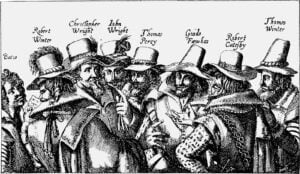
We have all heard of the Gunpowder Plot, we celebrate it every year on November 5th, but do you know why they felt they had to blow up the parliament?
It all goes back to King Henry VIII and 1534.
Henry’s Church
In 1534 Henry started the English Church and for it to succeed he had to do everything he could to damage the Church of Rome.
Therefore, he started desecrating the monasteries, then he found an additional bonus, they had lots of money! Suddenly his coffers were full again while at the same time he found his new religion was popular in the country, they preferred his rule to that of Rome. Unfortunately, there was a hard core of diehard Catholics who couldn’t and wouldn’t change their beliefs.
This was the start of a religious war that culminated nearly 70 years later with the Gunpowder Plot.
Elizabeth’s Church
When Henry’s daughter, Queen Elizabeth I, came to the throne she vowed to keep her father’s church going so she introduced the Elizabethan Religious Settlement. This demanded that everyone appointed to a public or church office had to swear allegiance to Elizabeth as head of the Church and state.
She was just as vicious as her father, as refusal meant fines for recusancy, and repeat offenders risked imprisonment and even on occasion execution! “Recusancy” was the word they chose for those people who stayed with the Catholic Church and refused to attend Church of England services.
Their attempt to banish Catholicism didn’t work, however no matter what threats they used catholic priests just kept working and holding services. They continued to do this in a world where they were tortured or even executed them when they were found out . Of course, all through this they were being supported, encouraged and, of course, continuously being praised by the Pope in Rome. The Pope made them heroes.
This continued until her death.
The Succession
Now this became interesting as Queen Elizabeth was childless, which meant that on paper Mary Queen of Scots was her legitimate heir. However, there was a problem, she was a Catholic, which they now call Papist. One that Elizabeth had eliminated when she was executed in 1587.
This led to her son King James VI of Scotland being the logical heir. Yet, it wasn’t as easy as that because the Papists felt the only real King had to be a Catholic monarch. There were several strong contenders unfortunately the Parliament were aware of this and wanted to keep the Church of England. This meant that before her death they had already started negotiating with James to make certain they had a protestant king.
The result was a smooth transition to King James as the Papists were hopeful that the new monarch would make life easier for them. Then, when in the next year he signed the Treaty of London with Spain they were even more confident.
James I
In fact, he started being more reasonable
For the Catholic expatriates engaged in that struggle, the restoration by force of a Catholic monarchy was an intriguing possibility but following the failed Spanish invasion of England in 1588 the Papacy had taken a longer-term view on the return of a Catholic monarch to the English throne.
Now around this time the Papists believed in Regicide. “Regicide” is the purposeful killing of a monarch or sovereign who is usurping power, therefore, by not supporting Catholicism, they believed it was justifiable. At this time Catholics across Europe had attempted several assassinations on Protestant rulers, in fact, they had even unsuccessfully planned to poison Elizabeth I.
Early plots
Once they started to lose hope that King James was not going to stop their persecution, they decided that they would do something about it.
On 19 February 1604
This was the date on which King James finally denounced the Catholic Church.
This led to these Gunpowder Plot.
First there was the Bye plot
The priests, William Watson and William Clark, put together a plan to actually kidnap the King then hold him in the Tower of London until he changed the laws.
News of the plot leaked out and therefore the Archpriest George Blackwell, instructed all priests not to take part such schemes.
The Main Plot
This plot was from Lord Cobham, Lord Grey de Wilton, Griffin Markham and Walter Raleigh who planned to remove King James and replace him with Arbella Stuart. As they needed funds for this plot to succeed they contacted Philip III of Spain for funding, but they were unsuccessful.
All those involved in both plots were eventually arrested in July and tried in autumn 1603; George Brooke was executed, but James, keen not to have too bloody a start to his reign, reprieved Cobham, Grey, and Markham while they were at the scaffold. Raleigh, who had watched while his colleagues sweated, and who was due to be executed a few days later, was also pardoned. Arbella Stuart denied any knowledge of the Main Plot. The two priests, condemned and “very bloodily handled”, were executed.
This led to the Gunpowder plot!
Educational Musicals
 Have published their schools music Gunpowder Plot – Remember, Remember the 5th of November which you can download at Gunpowder Plot – Remember, Remember the 5th of November
Have published their schools music Gunpowder Plot – Remember, Remember the 5th of November which you can download at Gunpowder Plot – Remember, Remember the 5th of November
It tells the story of how Robert Catesby, Thomas Winter and Thomas Percy plotted with Guy Fawkes to blow up the House of Commons. Their plan is simple, hire a cellar under the chamber and pack it with explosives and wait. This show explains how their cunning plot was foiled, then what happens to Guy Fawkes and his fellow conspirators.
Isn’t history fun?
10 questions to discuss:
- Who initiated the establishment of the English Church in 1534, and what was the primary motivation behind it?
- What actions did King Henry VIII take to undermine the Church of Rome and strengthen his newly formed English Church?
- How did Queen Elizabeth I enforce her religious policies, and what consequences did individuals face for refusing to comply?
- Describe the term “recusancy” and its significance in the context of religious conflict during Queen Elizabeth I’s reign.
- What challenges did Queen Elizabeth I’s succession dilemma pose regarding the continuity of the English Church?
- Who succeeded Queen Elizabeth I, and what were the religious implications of his ascension to the throne?
- Explain the concept of regicide and its relevance to the Catholic perspective during the reign of King James I.
- What events or circumstances led to the plotting of the Gunpowder Plot?
- Discuss the two main plots associated with the Gunpowder Plot and their outcomes.
- How did King James I respond to the individuals involved in the Gunpowder Plot, and what were the consequences for those implicated?
For more information try:
https://www.britannica.com/event/Gunpowder-Plot
https://www.history.com/topics/european-history/gunpowder-plot
©Tony Dalton

